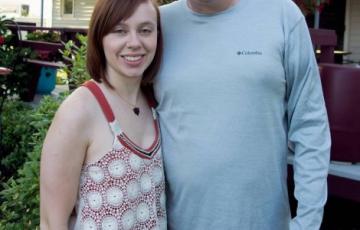Search Results
Diagnosis
While certain signs and symptoms may indicate that a person has ET, a series of tests are needed to confirm the diagnosis. It is important to have an accurate diagnosis, as it helps the doctor to:
- Estimate how the disease will progress
- Determine the appropriate treatment
Some of these tests may be repeated both during and after treatment to evaluate its effectiveness.
Treatment
Polycythemia Vera (PV) is a chronic disease: It's not curable, but it can usually be managed effectively for very long periods. The goal of therapy is to reduce the risk of thrombosis and to ease symptoms by lowering the number of extra blood cells.
Many treatment options are designed to manage PV by lowering hematocrit levels below 45 percent for men and 42 percent for women. Careful medical supervision and therapy is important to keep the hematocrit concentration at normal levels.
Infections
Cancer patients, especially those undergoing chemotherapy, are more likely to get infections because of their weakened immune systems. Cancer and certain cancer therapies can damage the immune system by reducing the number of infection-fighting white blood cells. Patients with a low white blood cell count are at a higher risk of developing infections, and these infections can be more serious and harder to treat. In severe cases, infections can lead to death.
Pain
A cancer diagnosis does not mean that you will have pain. Still, many people with cancer do have pain at some point. Good pain control is part of proper cancer care.
Managing pain may result in better treatment outcomes, so patients should talk to their healthcare team about their pain right away. Left untreated, pain can:
Dating, Sexuality & Intimacy
As a young adult you may be dating, in a relationship, or married. Cancer can make navigating romantic relationships complicated.
DatingDating can be intimidating no matter your situation. Remember, every date before your diagnosis probably did not go perfectly. You may have bad dates after your diagnosis as well. You may also meet incredible, new people.
Chemotherapy
Chemotherapy is the main treatment for ALL. The phases of treatment include the following:
Induction TherapyThe first phase of chemotherapy is called “induction therapy.” Induction therapy

Gerardo (Jerry)
I came into this world with a 65,000-mile warranty. During all my life, maybe I had a cold once in a while, some minor stuff, a bit of bursitis, but nothing that you would consider life-threatening at all. One day during a routine exam, I had blood work done. My PCP told me she didn't like my white blood cell count, and it was best to have a specialist look at it. She referred me to an oncologist. I didn’t think of it much, and since I was feeling fine, I thought it must be nothing of consequence.

Rick
Rick Ostroff and his family have a legacy of philanthropy with a heartfelt connection to a disease he never had. During the first three years of his life, he spent time on the leukemia floor of Children’s Hospital in Boston but eventually was found to have the critical illness of gamma globulin anemia rather than then-fatal leukemia.

Sofia
Sofia’s story starts in November 2022. Actually, it starts on March 17, 2019, when she was born. She has been my fierce, independent, strong-willed little girl from the get-go. Once she started walking, she was an unstoppable force. Contrary to her cautious, older brother, Sofia seemed fearless. She loved to climb to the top of the playground structure meant for kids twice her age. She loved gymnastics and took after Mommy with her love of the bars, anything she could hang or climb on.

Allie
When I was in fourth grade in 2015, my older brother Nate (a freshman in high school at the time) was rushed by ambulance to the U of M Masonic Children’s Hospital. His spleen was holding 10 times the normal amount of red blood cells. This led to the discovery of his cancer. He was later diagnosed with chronic myeloid leukemia (CML). He missed out on the first month of high school and hockey season, but he was able to take medicines at home so that he could eventually attend the rest of the school year.

Brianna
"He was the king of positivity" is what Dr. McCarthy at Roswell Park said to me the day after my Dad passed away from complications of GVHD or graft-versus-host disease. My Dad was a leader, someone who was always willing to help others, and always had a smile on his face. Not only was I his co-caregiver throughout his cancer journey, but he was also my caregiver during mine.

Amanda
"He was selfless, unbelievably selfless," said Amanda about her father, Andrew. "He did everything for everybody. He worried enough for our family plus more. And never showed it. He worked extremely hard to provide us with everything we could possibly need."

Tristan
I live in Colorado but grew up in Massachusetts and am an elite rock climber. I've traveled worldwide to climb and was the 2015 collegiate national champion. In April 2022, I was bouldering by myself and hit my shoulder on a rock behind me. Falls happen as frequently as a baseball player may swing a bat while climbing. This fall was nothing out of the ordinary except my shoulder was bruised far worse than I would expect from how hard I hit it, growing to the size of my hand by the next day. I remember looking at it initially and thinking, "Geez, I hope that's not leukemia."
#TILTCANCER - Start Your Charity Stream Today
#TiltCancer is The Leukemia & Lymphoma Society’s gaming & esports program. Join us and our community of content creators by creating a Livestream fundraiser, sign up for our video game fundraising events or become a #TiltCancer ambassador.
LLS PedAL - A pillar of the Dare to Dream Project
Through LLS PedAL, The Leukemia & Lymphoma Society (LLS) is setting out to fundamentally change how children with pediatric acute leukemia, including acute myeloid leukemia and other high-risk leukemias, are treated.
Donate Cryptocurrency
Support The Leukemia & Lymphoma Society by making a charitable gift in Bitcoin or another cryptocurrency. We accept donations in Bitcoin, Ethereum, and over 40 leading cryptocurrencies. Crypto donations are one of the most tax-efficient ways to give to charity
Diagnosis
Diagnosing acute lymphoblastic leukemia (ALL) and your ALL subtype usually involves a series of tests. An accurate diagnosis of the subtype is important. The exact diagnosis helps the doctor
Supportive Care
Treatment given to relieve the symptoms of a disease and the treatment’s side effects is known as supportive care. The goal of supportive care is to improve the patient’s quality of life and to relieve discomfort as much as possible. Supportive care is an important part of MDS treatment.
Stem Cell Transplantation
What are Stem Cells?Blood stem cells are produced in the marrow of the bones and can become any kind of blood cell the body needs. Stem cells are constantly dividing and maturing into different types of blood cells, replacing older and worn-out blood cells in the body. They produce billions of new blood cells every day. If the stem cells cannot make enough new blood cells, many serious health problems can occur. These problems may include infections, anemia or bleeding.
Low Blood Counts
Cancer therapy can lower your blood cell counts and chemotherapy especially can affect rapidly dividing bone marrow cells. This hinders the marrow's ability to supply new cells to the blood during treatment and for some time after. Patients receiving treatment for blood cancer can develop
Integrative Medicine and Complementary Therapies
Integrative medicine (IM) is a form of medical therapy that combines practices and treatments from complementary medicine (yoga, acupuncture and massage) with conventional medicine (surgery, chemotherapy, radiation treatment and immunotherapy). Many cancer patients are using integrative medicine (IM) to help ease their cancer symptoms and reduce the side effects of cancer treatment. By integrating complementary therapies into conventional treatment plans, healthcare providers are better able to address the physical, emotional and spiritual needs of their patients.
Family Planning Options
Options for Having a Family After TreatmentMany patients will be able to conceive naturally after cancer treatment. Patients are generally counseled to wait at least 2 years after treatment is completed before attempting conception. Check with your doctor to find out how long after treatment you should wait. If you are not able to conceive naturally, there are a number of other ways to build a family.

Krista
Prior to my diagnosis, I was a much-loved daughter to my parents, a dedicated dog mama to my Golden Retriever, a loyal friend, and an enthusiastic high school history teacher. After my diagnosis and seven-year battle with refractory Hodgkin lymphoma (HL), I was still all of those things and somehow so much more.